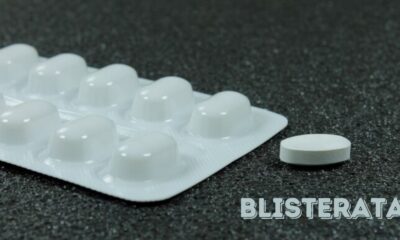Health
Combine B1 and MSM Together: A Powerful Duo for Health and Wellness

It is possible to increase the efficacy of supplements by taking them in combination. Combine B1 and MSM together (Methylsulfonylmethane), and you have a powerful tool for better health in general. Let’s take a look at what B1 and MSM do separately and how they might work together to form a formidable synergy.
Understanding Vitamin B1
One of the most important nutrients for the body’s energy generation is vitamin B1, which is also called thiamine. To keep the heart, muscles, and neurological system working properly, it aids in the conversion of carbs into energy. Having adequate energy to go about one’s everyday tasks depends on a healthy metabolism, which in turn depends on this vitamin.
Whole grains, meat (particularly pig), seafood, and legumes are natural sources of vitamin B1. On the other hand, dietary B1 intake alone may not be sufficient for certain individuals, necessitating supplementation. Vitamin B1 aids perspiration and general health by facilitating the body’s energy conversion mechanism.
What is MSM?
A naturally occurring molecule containing sulfur, MSM stands for Methylsulfonylmethane. Sulfur is a necessary ingredient for human health. Many people know that MSM helps keep joints healthy and reduces inflammation. Joint discomfort, inflammation, and the condition of the skin, hair, and nails are common complaints that this chemical helps with.
The synthesis of collagen, an essential protein for the preservation of healthy skin, joints, and connective tissues, is aided by MSM. Many individuals opt to take MSM supplements to attain the desired health advantages, because while it is available in foods like green leafy vegetables, garlic, onions, and milk, the levels are usually modest.
The Synergy Between Combine B1 and MSM Together
There is a powerful synergy between the benefits of vitamin B1 and MSM when used together. The anti-inflammatory characteristics of MSM aid in enhancing cellular health, while B1 promotes energy generation. Enhanced vitality, decreased inflammation, and general health are the results of this synergistic effect.
The capacity to promote joint health is one of the main advantages of combining B1 with MSM. The anti-inflammatory actions of MSM may alleviate joint discomfort and increase mobility, and the involvement of B1 in nerve function can boost these benefits even more. When used in tandem, they provide all-encompassing assistance in preserving sound, pain-free joints.
Health Benefits of Combine B1 and MSM Together
B1 and MSM, when taken together, have several positive effects on health. To start, this combination aids lessen tiredness and increases general vigor by increasing energy production. Both B1 and MSM are essential for the effective conversion of carbohydrates into energy, which is then used by cells.
Better joint health is an additional significant advantage. It’s no secret that MSM may help alleviate inflammation and bolster joint function. This combination, when used with B1, which aids in the maintenance of appropriate nerve function, may reduce joint discomfort, increase mobility, and improve joint health in general.
In addition, the immune system may be supported by combining B1 with MSM. White blood cells are vital for fighting off infections, and B1 helps with their formation. MSM has anti-inflammatory effects that help the immune system work efficiently. Together, they may improve health and fortify the immune system.
How to Take Combine B1 and MSM Together
It is critical to adhere to suggested doses and best practices in order to maximize the benefits of combining B1 with MSM. Adults usually take 1.1–1.2 mg of vitamin B1 daily, whereas MSM dosages may range from 1,000–4,000 mg, depending on personal health objectives.
If you want your supplements to be more effectively absorbed and cause less gas, take them with meals. To allow the body to adapt to the combination, it is recommended to start with a smaller dosage and gradually increase it. To get the most out of these supplements, you need to take them regularly as part of your regimen.
Potential Side Effects and Precautions
Although the majority of people do not suffer any negative side effects from B1 or MSM, a small number of persons may. Some of these side effects may include gastrointestinal distress, headaches, or nausea. Anyone with pre-existing medical concerns or who is taking other drugs should talk to their doctor before beginning a new supplement program.
Before mixing B1 with MSM, pregnant or nursing women should see a medical professional. To further guarantee there are no interactions, those using blood thinners or other particular drugs should talk to their doctor.
Who Can Benefit from This Combination?
Many people may get the benefits of taking B1 with MSM. Supporting joint health and increasing energy levels are two factors that athletes and fitness enthusiasts should prioritize if they want to perform at their best.
This combo may also help those who deal with arthritis or joint discomfort. By combining the anti-inflammatory properties of MSM with B1’s function in nerve function, pain and movement may be reduced, making everyday tasks more tolerable.
People trying to strengthen their immune system can also benefit from this mix. B1 and MSM complement one another to fortify the immune system, which in turn aids in disease prevention and general well-being.
Incorporating Combine B1 and MSM Together into Your Routine
You may easily add Combine b1 and MSM together to your regular regimen by taking pills or incorporating them into your food. You may get B1 and MSM on their own or as combination products that aim to bring forth their best synergistic benefits.
Make sure you take your vitamins consistently by keeping them in a conspicuous spot and setting a daily reminder. There are further advantages to eating foods that are high in B1 and MSM. You can receive a lot of these nutrients by eating foods like green vegetables, lean meats, and whole grains.
Conclusion
A potent method to improve your general health is to Combine b1 and MSM together.This combination has several uses and may help your health in many ways, including increasing your energy, supporting your joints, and bolstering your immune system. You can get the most out of this powerful combination by taking the supplements regularly and according to the dose instructions.
Health
The Healthy Primate Org: Your Ultimate Guide to Health and Wellness

Are you on the lookout for a holistic wellness program that offers personalized health guidance? Look no further than thehealthyprimate org. This platform is dedicated to promoting natural health and wellness, helping individuals lead healthier lives through a blend of fitness, nutrition, and mental well-being support. But what exactly is The Healthy Primate Org, and why has it gained such popularity? Let’s dive deeper.
What Makes The Healthy Primate Org Stand Out?
The Healthy Primate Org isn’t just another health and fitness platform. It’s a comprehensive wellness hub that places a strong emphasis on holistic health. Here’s what sets it apart:
Commitment to Natural Wellness: At the core of The Healthy Primate Org is its dedication to embracing natural health practices. This means avoiding harmful chemicals, promoting organic foods, and focusing on sustainable health practices.
Focus on Education: The organization believes that education is key to achieving long-term health goals. Whether it’s through blog posts, webinars, or expert consultations, The Healthy Primate Org ensures that you have the knowledge to make informed decisions about your health.
Core Principles of Thehealthyprimate org
What principles guide The Healthy Primate Org in its mission to help people achieve better health? Here are the three pillars of its approach:
Holistic Health Approach: The Healthy Primate Org doesn’t just focus on one aspect of health but considers the whole person—mind, body, and spirit. This approach ensures that your well-being is balanced and sustainable.
Integrating Mind, Body, and Spirit: Your physical health is important, but so is your mental and emotional well-being. The Healthy Primate Org integrates practices like mindfulness, yoga, and stress management alongside physical health routines to create a well-rounded approach to wellness.
Importance of Nutrition and Exercise: The Healthy Primate Org promotes a healthy lifestyle by prioritizing proper nutrition and exercise. Through expert advice and tailored meal plans, users learn how to fuel their bodies and engage in physical activities that align with their goals.
MUST READ: www healthsciencesforumcom: Your Go-To Source for Reliable Health Information
Services and Offerings
What can you expect when you sign up for The Healthy Primate Org? Let’s explore some of the most popular services and offerings:
Health Coaching: Whether you need motivation, personalized advice, or just someone to guide you along your health journey, the health coaches at The Healthy Primate Org are there to support you every step of the way.
Meal Planning and Nutrition: The organization offers tailored meal plans that cater to different dietary needs, helping you make healthier food choices that fuel your body and optimize your health.
Fitness Programs: From yoga to strength training, The Healthy Primate Org provides a range of fitness programs designed to help you stay active and achieve your fitness goals.
Mental Health Support: Mental well-being is just as important as physical health. The platform offers resources and guidance on managing stress, anxiety, and other mental health challenges.
How The Healthy Primate Org Supports a Balanced Lifestyle
Achieving a balanced lifestyle isn’t easy, but The Healthy Primate Org makes it simple. Here’s how:
Personalized Wellness Plans: You’ll receive customized wellness plans based on your specific needs, preferences, and goals. This ensures that the programs you follow are aligned with your lifestyle.
Customizable Programs for Different Lifestyles: Whether you’re a busy professional, stay-at-home parent, or athlete, The Healthy Primate Org’s flexible programs cater to different lifestyles and help you stay on track with your health goals.
Access to Expert Advice: The platform offers access to certified health experts who can provide guidance and answer your questions about nutrition, fitness, and overall wellness.
The Healthy Primate Org Blog: Knowledge at Your Fingertips
The Healthy Primate Org offers a rich resource in the form of its blog, filled with helpful articles and practical tips. Topics covered include:
Health Tips and Articles: From improving sleep habits to boosting energy levels, the blog offers practical advice to help you live a healthier life.
Recipes and Meal Ideas: If you’re struggling to come up with healthy meal ideas, the blog has a variety of recipes to suit every dietary need, whether you’re vegan, keto, or just looking to eat healthier.
Wellness Challenges and Programs: The blog also offers challenges and programs to help you stay motivated and on track with your wellness journey.
Testimonials from Real Users
The best way to understand the impact of The Healthy Primate Org is by hearing from real users. Many have shared their success stories and personal experiences, highlighting how the platform has helped them improve their health and live better lives. These testimonials serve as a testament to the effectiveness of the programs offered.
The Science Behind The Healthy Primate Org’s Approach
The Healthy Primate Org’s approach is grounded in research and evidence-based strategies. The organization doesn’t just offer vague health advice but uses science-backed methods to ensure that the wellness strategies it promotes are effective and safe.
Research-Driven Methods: All the health advice, coaching, and programs are based on current research, ensuring you receive the best possible guidance.
Evidence-Based Health Strategies: The strategies used by The Healthy Primate Org are proven to work, with real-world evidence and success stories supporting their effectiveness.
Why Choose Thehealthyprimate org for Your Wellness Journey?
Choosing a wellness program is an important decision. Here’s why The Healthy Primate Org is an excellent choice:
Trust and Credibility: The platform has built a reputation for being reliable, credible, and effective in helping people achieve their health goals.
Community and Support: You’re never alone on your wellness journey. The Healthy Primate Org fosters a supportive community where members encourage each other and share tips.
How to Get Started with The Healthy Primate Org
Ready to begin your wellness journey? Getting started with The Healthy Primate Org is easy:
- Sign Up: Create an account on the platform and fill out a health assessment to help tailor the program to your needs.
- Choose Your Plan: Select the wellness services that best suit your goals. Whether you’re looking for fitness coaching, meal planning, or mental health support.
- Start Your Journey: Begin following your personalized wellness plan and enjoy access to expert advice and resources along the way.
The Future of The Healthy Primate Org
Thehealthyprimate org has big plans for the future, with plans to expand its services and features. As it grows, it aims to offer even more tailored wellness programs, resources, and tools to support a wider audience.
FAQs
How do I sign up for The Healthy Primate Org?
Signing up is simple! Visit their website, create an account, and fill out the health assessment to get started.
What types of wellness services are offered?
The platform offers health coaching, meal planning, fitness programs, and mental health support.
How do I know if The Healthy Primate Org is right for me?
The Healthy Primate Org provides personalized plans tailored to your specific goals. Ensuring it’s a great fit for anyone looking to improve their overall health.
What makes The Healthy Primate Org different from other wellness programs?
Its holistic approach and commitment to education. And research set it apart from other programs, offering a balanced focus on mind, body, and spirit.
How can I track my progress with thehealthyprimate org?
The platform provides tools and expert advice to help you track your health journey, including fitness progress and wellness milestones.
Health
Greenpics CBD Protein Bars: A Comprehensive Guide to Benefits, Ingredients, and More

In recent years, health-conscious individuals have been constantly seeking out innovative and effective ways to fuel their bodies while maintaining a balanced lifestyle. Enter Greenpics cbd proteine bars – a powerful fusion of two wellness trends: protein-rich snacks and the ever-popular cannabidiol (CBD). But what makes these protein bars so special? Let’s dive into the specifics and explore the benefits, ingredients, and why they might be the perfect addition to your daily routine.
1. Understanding CBD: What It Is and Why It Matters
Before we dive into the specifics of greenpics cbd proteine bars, it’s crucial to understand CBD itself. CBD, short for cannabidiol, is a non-psychoactive compound found in cannabis plants. Unlike its cousin THC (tetrahydrocannabinol), CBD doesn’t get you “high” but has a wide array of potential health benefits, ranging from stress relief to pain management.
2. The Benefits of CBD in Protein Bars
When CBD is combined with protein, it creates a powerhouse snack that offers more than just the physical benefits of protein. CBD has been shown to support mental clarity, reduce anxiety, and help with muscle recovery, making it a perfect complement to the protein boost provided by these bars.
YOU MAY LIKE: www healthsciencesforumcom: Your Go-To Source for Reliable Health Information
3. Greenpics CBD Protein Bars: The Brand Overview
Greenpics is a well-known brand in the wellness space, offering a variety of products infused with CBD. Their protein bars stand out by not only providing high-quality protein but also offering the potential therapeutic benefits of CBD in a convenient snack form. These bars are designed for people who want to enhance their physical performance while also supporting their mental well-being.
4. Key Ingredients in Greenpics CBD Protein Bars
Greenpics CBD Protein Bars are made with a combination of healthy, natural ingredients that are both nutritious and delicious. Some of the key ingredients include:
Whey Protein: Known for its ability to support muscle growth and recovery, whey protein is a popular choice for athletes and fitness enthusiasts.
CBD Isolate: The purest form of CBD, ensuring you receive the maximum benefits without any psychoactive effects.
Almonds & Seeds: These provide healthy fats and fiber, which contribute to sustained energy and overall health.
Natural Sweeteners: Greenpics uses ingredients like stevia or monk fruit to sweeten their bars naturally, avoiding refined sugars.
5. The Nutritional Value of Greenpics CBD Protein Bars
Each bar is packed with essential nutrients to fuel your body throughout the day. Typically, a Greenpics CBD Protein Bar contains around 20-25 grams of protein, making it an excellent choice for a post-workout snack. Additionally, the bars are often low in sugar and carbohydrates, making them a great option for those following a low-carb or ketogenic diet.
6. How Greenpics CBD Protein Bars Help with Recovery
One of the standout benefits of Greenpics CBD Protein Bars is their potential to enhance recovery. After intense physical activity, your muscles need the right nutrients to repair and grow. The combination of protein and CBD can help reduce inflammation, improve muscle recovery, and alleviate soreness, ensuring you’re ready to tackle your next workout without skipping a beat.
7. Mental Clarity and Focus with CBD Protein Bars
CBD’s potential to help manage stress, anxiety, and even mild depression can be a game-changer for anyone looking to maintain mental clarity. Whether you’re navigating a busy workday or gearing up for an intense workout, Greenpics CBD Protein Bars may provide a natural way to stay calm and focused. This can improve both your physical and mental performance.
8. The Taste Factor: Are They Delicious?
No matter how beneficial a product is, its taste matters. Luckily, Greenpics CBD Protein Bars are known for being delicious and satisfying. The rich, nutty flavors combined with a soft, chewy texture make them a treat you’ll look forward to after a workout or as a quick energy boost during the day.
9. When to Eat Greenpics CBD Protein Bars
The beauty of Greenpics CBD Protein Bars is that they can be consumed at various times throughout the day, depending on your needs:
Post-workout: To support muscle recovery and reduce inflammation.
Mid-day snack: For a satisfying, protein-packed snack that boosts energy.
Before bed: The calming effects of CBD can help you unwind and prepare for a restful night of sleep.
10. Greenpics CBD Protein Bars for Athletes and Fitness Enthusiasts
Athletes and fitness enthusiasts often look for ways to maximize their performance, and Greenpics CBD Protein Bars offer a unique combination of benefits. The protein content helps with muscle repair, while the CBD supports mental relaxation and reduces the effects of physical strain. Whether you’re a casual gym-goer or a seasoned athlete, these protein bars could be the ideal snack to support your training.
11. Are Greenpics CBD Protein Bars Safe?
When consuming CBD products, it’s natural to wonder about their safety. Greenpics CBD Protein Bars are made with high-quality, third-party tested CBD to ensure that the products meet the highest safety standards. Always check for lab results and ensure that the CBD is sourced from trusted suppliers to guarantee quality.
12. Where to Buy Greenpics CBD Protein Bars
Greenpics CBD Protein Bars can be found through their official website or at select health food stores and online retailers. It’s always recommended to purchase from trusted sources to avoid counterfeit products and ensure that you are getting the full benefits of the CBD.
13. Greenpics CBD Protein Bars vs. Other CBD Protein Bars
What sets Greenpics apart from other CBD-infused protein bars on the market? While many bars combine protein and CBD, Greenpics stands out due to its high-quality ingredients, delicious flavors, and commitment to providing consistent doses of CBD in each serving. Compared to some other brands, Greenpics bars offer a balanced combination of nutrition and wellness benefits.
14. The Environmental Impact of Greenpics CBD Protein Bars
Greenpics is also committed to sustainability. The brand uses eco-friendly packaging, and they prioritize sourcing their ingredients from responsible suppliers who value environmental conservation. So, by choosing Greenpics CBD Protein Bars, you’re not just supporting your health but also the planet.
15. Conclusion
Greenpics CBD Protein Bars offer a unique, healthy, and convenient way to fuel your body while also enjoying the potential benefits of CBD. Whether you’re an athlete, fitness enthusiast, or someone just looking for a delicious and nutritious snack, these bars could be the perfect addition to your routine. With their high protein content, delicious taste, and potential wellness benefits, they are definitely worth considering.
Frequently Asked Questions (FAQs)
What makes Greenpics CBD Protein Bars different from other protein bars?
Greenpics combines high-quality protein with CBD, offering not only physical benefits like muscle recovery but also mental wellness benefits.
Can I eat Greenpics cbd proteine bars every day?
Yes! They are design to be part of a balance diet and can be eat daily, whether as a post-workout snack or a mid-day energy boost.
How long does it take for the CBD to take effect?
CBD effects can vary, but many users report feeling calmer and more focused within 30 minutes to an hour of consuming CBD.
Can CBD protein bars help with sleep?
CBD has calming effects that can help some people unwind, making Greenpics cbd proteine bars a great option to enjoy before bedtime.
Health
www healthsciencesforumcom: Your Go-To Source for Reliable Health Information

In the extensive realm of the net, finding reliable health records can be pretty a challenge. That’s in which www healthsciencesforumcom steps in. This platform serves as a complete hub for fitness lovers, experts, and everybody eager on retaining up with the trendy inside the global of health sciences. But what makes it stand out from the plethora of health web sites accessible?
Navigating Health Sciences Forum
One of the primary things you may word about Health Sciences Forum is its person-pleasant interface. The internet site is designed to be intuitive, making it clean for even the least tech-savvy individuals to navigate. The registration process is easy, requiring simplest fundamental facts to get commenced. Once registered, users can customize their profiles, making the enjoy even greater tailor-made to their desires.
Discussion Boards
The heart of www healthsciencesforumcom lies in its vibrant discussion boards. These are categorized into diverse health topics, making sure that users can discover relevant discussions effortlessly. Whether you are looking to talk about the modern research in cardiology or need recommendations on preserving mental health, the discussion forums have something for absolutely everyone.
Expert Panels
Another standout characteristic is the professional panels. These panels consist of health experts who regularly make contributions to the forum, imparting precious insights and answering consumer queries. This now not only provides a layer of credibility but additionally guarantees that the facts shared is correct and honest.
Resource Library
The useful resource library is a treasure trove of facts. From studies papers to health recommendations, users have get right of entry to to a wide variety of resources which could assist them stay informed and make higher health selections.
Medical Research
Stay up to date with the state-of-the-art findings in scientific studies. The discussion board presents summaries and discussions on current studies, making complicated records extra available to the overall public.
Health and Wellness Tips
Looking for practical advice on staying healthy? The forum is brimming with tips and tricks on nutrients, workout, mental fitness, and common health.
Patient Experiences
One of the specific components of www healthsciencesforumcom is the point of interest on patient studies. Users can percentage their health trips, supplying support and encouragement to others going through comparable demanding situations.
Access to Reliable Health Information
In an technology wherein incorrect information is rampant, having access to dependable fitness data is important. Health Sciences Forum guarantees that the facts shared is credible and subsidized with the aid of experts.
Community Support
Being a part of a community can be particularly comforting, specially whilst handling fitness troubles. The forum provides a supportive environment wherein users can proportion their reports and provide recommendation.
Professional Networking
For fitness specialists, the forum gives superb networking opportunities. Connect with friends, percentage research, and collaborate on projects – the possibilities are infinite.
Engage in Discussions
Don’t be a passive player. Join discussions, ask questions, and proportion your understanding. The extra you engage, the greater you will benefit.
Utilize Resources
Make full use of the useful resource library. Whether you are a health expert seeking out studies papers or a layperson seeking fitness hints, the library has you included.
Connect with Experts
Take benefit of the professional panels. Don’t hesitate to ask questions and searching for recommendation from the fitness professionals who contribute to the discussion board.
Case Studies
Numerous case studies on the discussion board exhibit how users have benefited from the information and assist supplied. From managing persistent ailments to attaining health dreams, the achievement stories are inspiring.
User Testimonials
The testimonials from customers paint a vivid photo of the forum’s effect. Many users credit score Health Sciences Forum for their advanced fitness and nicely-being, highlighting the cost of being part of one of these colourful community.
Unique Features
While many health web sites provide records, Health Sciences Forum combines this with interactive capabilities like dialogue boards and professional panels. This makes it more than simply an records portal – it is a dynamic network.
Comparisons
When as compared to other fitness forums, Health Sciences Forum sticks out for its commitment to offering reliable facts and fostering a supportive network. The professional involvement provides a layer of credibility that many other forums lack.
Data Protection Measures
The platform employs sturdy statistics safety measures to make sure that consumer facts is stable. This includes encryption and regular security audits.
User Anonymity
Users additionally have the choice to stay anonymous, which is especially crucial for those discussing touchy health issues. This anonymity fosters a more open and honest dialogue environment.
Upcoming Features
The group in the back of the forum is continually running on new features to decorate the person experience. This consists of improved cell accessibility, new discussion categories, and greater interactive gear.
Community Feedback
User remarks plays a important position in these traits. The forum actively seeks input from its contributors to ensure that their needs are being met and to constantly enhance the platform.
Conclusion
In conclusion, www HealthsciencesforumCom is a precious aid for every body interested by fitness sciences. With its comprehensive features, supportive community, and dedication to imparting reliable records, it stands out as a top desire for fitness fanatics and experts alike. So why wait? Join the Health Sciences Forum today and take a proactive step closer to better fitness and nicely-being.
FAQs
What is Health Sciences Forum?
Health Sciences Forum is an online platform dedicated to providing reliable health information and fostering a supportive community for health enthusiasts and professionals.
How do I join Health Sciences Forum?
Joining is easy. Simply visit the website, complete the registration process, and start exploring the wealth of information and resources available.
Is my data safe on Health Sciences Forum?
Yes, the forum employs robust data protection measures to ensure user information is secure, including encryption and regular security audits.
Can I connect with health professionals on Health Sciences Forum?
Absolutely. The forum features expert panels where health professionals contribute regularly, providing valuable insights and answering user queries.
Are there any fees to use Health Sciences Forum?
No, joining and using Health Sciences Forum is completely free. All you need to do is register and start engaging with the community.
-

 LIFE STYLE3 months ago
LIFE STYLE3 months agoExploring the World: A Journey with myfavouriteplaces.org
-

 EDUCATION10 months ago
EDUCATION10 months agoλιβαισ: Unraveling the Cultural Enigma
-

 BUSINESS10 months ago
BUSINESS10 months agoRetra: Revolutionizing Workflow Management
-

 Health3 months ago
Health3 months agowww healthsciencesforumcom: Your Go-To Source for Reliable Health Information
-

 ENTERTAINMENT3 months ago
ENTERTAINMENT3 months agoHow Ollyhibs TikTok revolutionized sports industry
-

 TECHNOLOGY10 months ago
TECHNOLOGY10 months agoUnlocking the Potential: Exploring the Power of GPT66X
-

 HEALTH & FITNESS10 months ago
HEALTH & FITNESS10 months agoUnderstanding Blisterata: Causes, Symptoms, and Treatment
-

 VAPE9 months ago
VAPE9 months agoHush Absolute Vape: Elevate Your Vaping Experience










